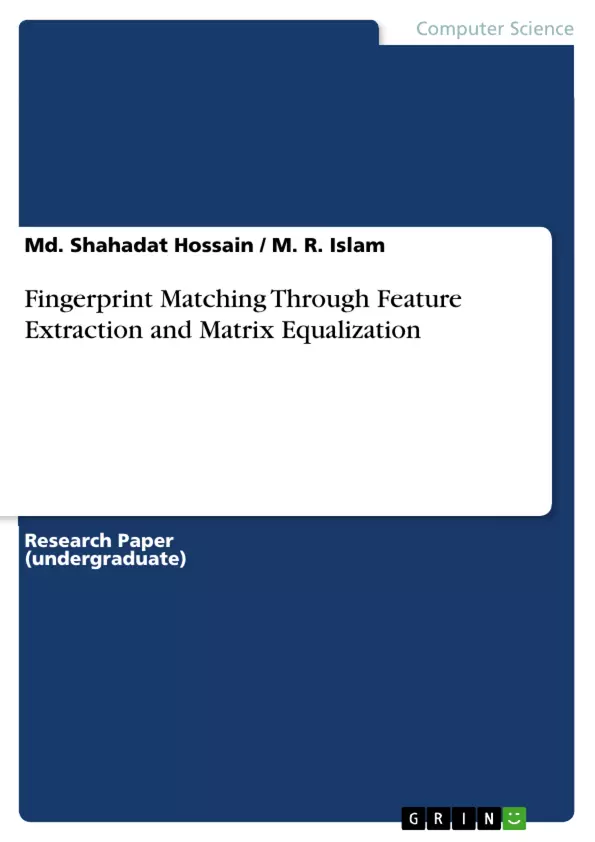Minutiae based feature extraction methods are used for fingerprint matching. This method is mainly depending on the characteristics of minutiae of the individuals. The minutiae are ridge endings or bifurcations on the fingerprints. Their coordinates and direction are most distinctive features to represent the fingerprint. Most fingerprint matching systems store only the minutiae template in the database for further usage. The conventional methods to utilize minutiae information are treating it as a point set and finding the matched points from different minutiae sets. This kind of minutiae-based fingerprint recognition/matching systems consists of two steps: minutiae extraction and minutiae matching. Image enhancement, histogram equalization, thinning, binarization, smoothing, block direction estimation, image segmantation, ROI extraction etc. are discussed in the minutiae extraction step. After the extraction of minutiae the false minutiae are removed from the extraction to get the accurate result. In the minutiae matching process, the minutiae features of a given fingerprint are compared with the minutiae template and the matched minutiae will be found out. The final template used for fingerprint matching is further utilized in the matching stage to enhance the system’s performance. Two fingerprint images always give two different matrices, the matrix equalization method is also used for matching two fingerprint images after the final template.
Inhaltsverzeichnis (Table of Contents)
- I. INTRODUCTION
- II. METHODOLOGY
- 2.1 Fingerprint matching algorithm
- 2.2 Input images & Histogram equalization
- 2.3 Edge detection
- 2.4 Binarization of the input fingerprints
- 2.5 Image Segmentation
- 2.5.1 Block direction estimation
- 2.6 Thinning of the input fingerprint
- 2.7 Minutiae extraction
- 2.8 Minutiae matching
- 2.9 Matrix equalization
- III. RESULTS AND DISCUSSION
- IV. CONCLUSION
- V. REFERENCES
Zielsetzung und Themenschwerpunkte (Objectives and Key Themes)
This paper aims to explore the process of fingerprint matching through feature extraction and matrix equalization. It delves into the intricacies of minutiae-based fingerprint recognition, highlighting the key steps involved in extracting and matching minutiae features.
- Minutiae extraction and matching
- Image enhancement techniques
- Binarization and thinning processes
- Block direction estimation and image segmentation
- Matrix equalization for fingerprint comparison
Zusammenfassung der Kapitel (Chapter Summaries)
The paper begins by introducing the concept of fingerprint matching as a widely used biometric authentication system. It emphasizes the uniqueness of fingerprints and their applications in various fields, including banking security, access control, and identification systems.
The methodology section delves into the fingerprint matching algorithm, outlining the steps involved in processing fingerprint images. This includes histogram equalization for contrast enhancement, binarization for converting grayscale images to binary, and edge detection for reducing data complexity. The paper then discusses image segmentation, particularly block direction estimation, which helps identify regions of interest within the fingerprint image. Thinning, a process that transforms the binary pattern into a skeleton, is also explained. The chapter concludes with a detailed explanation of minutiae extraction, minutiae matching, and matrix equalization, which are crucial for comparing and matching fingerprints.
Schlüsselwörter (Keywords)
The key words and focus themes of the text include fingerprint matching, minutiae extraction, minutiae matching, binarization, smoothing, image segmentation, matrix equalization, and bifurcation. The paper explores the use of these techniques in fingerprint recognition systems, highlighting their role in enhancing image quality, extracting distinctive features, and comparing fingerprints for authentication purposes.
- Quote paper
- Md. Shahadat Hossain (Author), Dr. M. R. Islam (Author), 2014, Fingerprint Matching Through Feature Extraction and Matrix Equalization, Munich, GRIN Verlag, https://www.grin.com/document/293865



